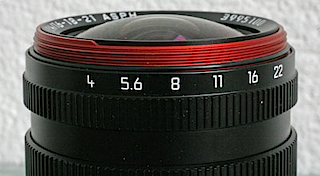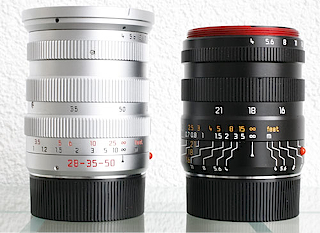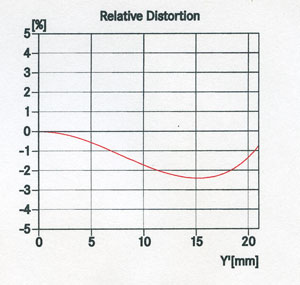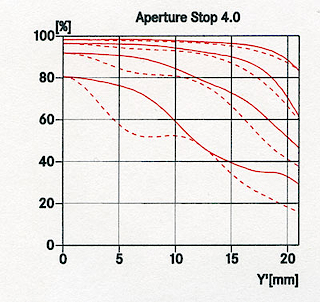Background
Half a century ago, when the Leica M3 was introduced, wide-angle lenses were still a rarity and extreme wide-angle lenses were unknown, except for the laboratory applications. A 21mm lens could be used on the M camera because the absence of a mirror allowed the design of a deeply recessed optical cell. The rangefinder camera is very suited for the employment of wide-angle lenses of a traditional optical design and for a long time the designers had no other choice. Now we can create retro-focus designs that are as good if not better than the classical constructions. Very high quality designs ask for volume as the ZM 2.8/15mm demonstrates.
Leica has been quite reluctant to engage themselves with lenses of extreme angles. They stopped at 21mm, a classical limit for almost a century now. Cosina showed that there is a market for lenses with a wider angle if they could be marketed at a lower price. And these lenses are very good indeed. But Leica designs by nature are expensive and the buyer wants value for money, even if it bears the Leica name. Part of the cost of a Leica lens stems from the selection of very high grade glass, the elaborate mechanical mount and the careful manual assembly. This expertise is not so easy to export as the Zeiss example shows: the more elaborate designs are assembled in Germany and only designs that are more tolerant for small assembly errors are manufactured in Japan. If the same lavish attention to detail and careful quality control would introduced in a Japanese assembly line, the cost advantage would be quite small. See the price difference between the 14-50 D mm lens for the Digilux 3 and one with the same specs from Olympus.
Part of the cost of the Leica lens can be attributed to the small number of lenses that are being produced. But here one of the bigger advantages for Leica lenses originates. When a Japanese company designs a lens the volume is such that any part needed for the lens can be manufactured as a mass-produced item. The cost for special tooling can be shared by a hundred thousand items
Leica cannot do this, but the new line of equipment that has been introduced in the last couple of years can be programmed in a flexible way and can create quite complex pieces of metal. See my report of the 28-90mm lens for the R-system, where a very complex optical movement was made possible by a new type of mount that was machined in a way that was not possible even recently.
Adding a and b, the Leica designers assumed that a new lens in the wide angle range needed added value to be of interest for the buyer.
The first Tri-Elmar has one of the most complex mounts ever designed for a Leica lens. The complexity of the mount was required because the lens had to actuate the frame lines in the camera body and this simple demand was a headache for the designers. They created a fine solution, but the non-linear movement with steep curves lacked the smoothness of operation one habitually attributes to the Leica name.
A new lens should be an improvement and add new features.
The specifications
(Basic specs can be found at the Leica website and will not be shown in this report).
 The new Tri-Elmar has three focal lengths of 16, 18 and 21mm with a constant aperture of f/4. It is extremely compact and operates with silk-smooth precision. Optically it is quite impressive: a 16mm in such a small size is an optical and engineering feat of some importance. The lens now has a linear movement, which simplifies the design somewhat, but the addition of internal focusing adds complexity. It is obvious that much thinking has been done to finalize this lens design. Ten elements in six groups are required to deliver the required optical performance and for an M lens this is a large number of elements.
The new Tri-Elmar has three focal lengths of 16, 18 and 21mm with a constant aperture of f/4. It is extremely compact and operates with silk-smooth precision. Optically it is quite impressive: a 16mm in such a small size is an optical and engineering feat of some importance. The lens now has a linear movement, which simplifies the design somewhat, but the addition of internal focusing adds complexity. It is obvious that much thinking has been done to finalize this lens design. Ten elements in six groups are required to deliver the required optical performance and for an M lens this is a large number of elements.
Normally the lens mount has a screw-thread that holds the filter mount. The classical design implies that the lens mount must be larger than is needed for the lens diameter. The compactness of the lens has been made possible by a novel method of attaching a separate filter holder and the lens hood. It is a patented thread that stops the hood and filter holder at a specified position; independent of where you begin the movement. It has the same secure lock and precise position as a bayonet.
The internal focusing mechanism allows the use of the lens till 50cm and when you maximally employ the extended depth of field, good quality can be delivered for objects at 33cm in front of the lens. One should not expect wonders here. It is nice to have, but the limit for the coupling of the rangefinder is 70cm: the distance setting for 50cm must be guessed (an act that is not common nowadays) or measured with a tape. Maybe Leica should have added a measuring tape for that distance to the lens set.
The focal length of 16mm and 18mm are new for a Leica user. The 21mm focal length is well-known. It seems a small difference of only 2 mm between the two positions, but in practical photography you see that difference in angle of view and perspective. It is not easy to find motives where you can exploit the extreme angle, but architectural photography is an obvious example.
Below you see a set of pictures where the change in angle of view is visible. I have tested this lens on the M7 as this is the most demanding situation where the full potential of the lens is asked for.
When used on the M8, the angle is reduced and the 16mm focal length gives the view of the 21mm with the magnification of the 16mm! The new additional finder has frame lines for both sets of viewing angles, but is not a compact piece of equipment.
The performance
Most zoom lenses have an optimum setting somewhere across the range and at other positions a drop in image quality is visible. This 3E is an exception to that rule. At all three focal length positions we see a medium to high overall contrast wide open with outstandingly good definition over two-thirds of the full 35mm image format. At the edges and in the corners the recording of fine detail is of lower contrast, but outlines of subject detail is quite good preserved. Stopping down improves the edges and corners to a level where even demanding requirements are satisfied.
Curvature of field is well controlled, but one can note that at the 16 and 18mm positions the geometrical distortion (which is not an optical, but a geometrical phenomenon) is visible as an elongation of subjects in a horizontal direction. The correction of the curvature of field is a balancing act with the result that the crispness of very fine detail is slightly reduced.
The lens is remarkably flare resistant, certainly when you consider the wide viewing angle. Even shooting straight against the sun did not generate any ghosting effects.
Vignetting is on paper quite high with three stops in the corners and is on the same level as the Noctilux. But in practical photography I could not notice this phenomenon unless I underexposed by a stop or more, It will depend on your style of photography whether the vignetting at full aperture is visible/acceptable or not.
Distortion on the other hand is visible at all three focal lengths. At 16mm the distortion value is above 3%. That seems to be a high value, but we should relate it to the extrme wide angle of the lens. The same 3% we have also in the original 3E at the 28mm position. Other wide angle lenses in the range of 14 tot 18mm often have 5% or more.

The shape of the distortion curve is such that pictures taken with the M8 will exhibit distortion even in the horizontal top of the image. Presumably Photoshop and other software that can reduce distortion effects will reduce the effect. In the digital age of post processing, issues of distortion and vignetting and even contrast are less important than they were when the more honest silver halide recording media ruled the waves.
Close up performance at 50cm is very good, but one should keep in mind that a 16mm still covers a large frame of reality.
The unsharpness gradient is very smooth and objects at a wider distance from the sharpness plane are still recorded with good definition of outlines. You need a careful composition and close contact with the scene to isolate the main subject from its surroundings. But that is the challenge.

The MTF graphs can be found at the Leica website. Here I reproduce one. The somewhat meandering lines at the 40 lp/mm position are the consequence of the optimized correction of the ray aberrations. One should not give them too much attention.
Conclusion.
The 3E 16-21 is a superb example of mechanical and optical engineering at its finest. For the M user this lens opens up new vistas and creative possibilities, hitherto unavailable from the Leica M catalogue. Performance wise the lens at all three focal lengths is on a par with the competition. With only three lenses, 3E 16-21mm, 24mm, 3E 28-50mm, the Leica M user can cover the whole gamut of wide angle to normal focal lengths from 16 to 50mm or for M8 from 21 to 70mm viewing angle.
The photographer with high-resolution ambitions needs a tripod, a low-speed microfilm and an aperture of f/8 to comply with demands, but it can be done. And for the handheld shooter who wants fresh and novel impressions can use the lens without focusing, and trust the depth of field when taking emotionally inspired pictures.